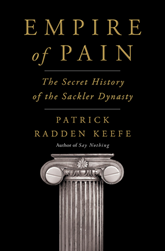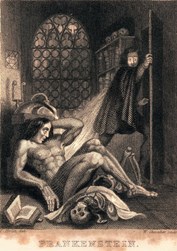Frankenstein and an Empire of Pain
May 07, 2021
On the creation of a fictional monster in 1800s England, and those who did well off the proceeds of a drug so easily abused that it became a monster in modern-day America.
 Patrick Radden Keefe's new book, Empire of Pain, an impressive examination of the family that built up a fortune on the sale of opioid painkiller OxyContin, has received a lot of well-deserved accolades since it was released last month. As I read the book, I found myself thinking a surprising amount about Mary Shelley’s Frankenstein, and not because Mary Shelley’s husband, poet Percy Bysshe Shelley, was a known opium user. (There are any number of literary scholars who credit Mary Shelley’s inspiration for Frankenstein to the couple’s bacchanalian lifestyle, rather predictably and rather patriarchically assigning the origins of the doctor and/or the monster to her husband’s bad behavior and/or his compulsive approach to art.) Instead, I found intriguing parallels between the questions of moral responsibility presented in both books.
Patrick Radden Keefe's new book, Empire of Pain, an impressive examination of the family that built up a fortune on the sale of opioid painkiller OxyContin, has received a lot of well-deserved accolades since it was released last month. As I read the book, I found myself thinking a surprising amount about Mary Shelley’s Frankenstein, and not because Mary Shelley’s husband, poet Percy Bysshe Shelley, was a known opium user. (There are any number of literary scholars who credit Mary Shelley’s inspiration for Frankenstein to the couple’s bacchanalian lifestyle, rather predictably and rather patriarchically assigning the origins of the doctor and/or the monster to her husband’s bad behavior and/or his compulsive approach to art.) Instead, I found intriguing parallels between the questions of moral responsibility presented in both books.
 Over two centuries have passed since Shelley wrote her story of ‘man creates monster.’ In that time, Victor Frankenstein the man has been so conflated with the monster he created that when we dress up for Halloween, we simply refer to the monster as Frankenstein. It is the monster that has become the indelible image created out of Shelley’s words, made alive from her text, but Shelley titled her book Frankenstein because the intended focus of her story was the doctor himself, on the dangers of unfettered scientific experiment supposedly in the name of progress, and the resultant moral responsibility of ‘playing God.’
Over two centuries have passed since Shelley wrote her story of ‘man creates monster.’ In that time, Victor Frankenstein the man has been so conflated with the monster he created that when we dress up for Halloween, we simply refer to the monster as Frankenstein. It is the monster that has become the indelible image created out of Shelley’s words, made alive from her text, but Shelley titled her book Frankenstein because the intended focus of her story was the doctor himself, on the dangers of unfettered scientific experiment supposedly in the name of progress, and the resultant moral responsibility of ‘playing God.’
There are as many interpretations of Shelley’s work as pages in the book, and understandably so. The questions she posed are an evergreen interrogation of humankind’s capacity to create and the ramifications of that power. Humans, she asserts, are relentless in their pursuit of knowledge and discovery, often at a cost either unintended or unpredictable (and that many come to find as unacceptable).
Frankenstein is a man enamored and compulsive in his studies, his curiosity set alight in the classroom by his mentor’s words:
“The ancient teachers of this science,” said he, “promised impossibilities and performed nothing. The modern masters promise very little; they know that metals cannot be transmuted and that the elixir of life is a chimera but these philosophers, whose hands seem only made to dabble in dirt, and their eyes to pore over the microscope or crucible, have indeed performed miracles. They penetrate into the recesses of nature and show how she works in her hiding-places. They ascend into the heavens; they have discovered how the blood circulates, and the nature of the air we breathe. They have acquired new and almost unlimited powers; they can command the thunders of heaven, mimic the earthquake, and even mock the invisible world with its own shadows.”
The language that Shelley uses here is so hyperbolic as to imply parody. Humans have been elevated to a status above nature, their capabilities those of control, not coexistence, achievement, not assimilation. Spurred by such illusions of grandeur, Frankenstein begins his pursuit of creating life, or more correctly reanimating life, with little consideration beyond the accomplishment itself. What, one might ask, was his plan after he achieved his scientific breakthrough? What then? The story of the monster’s life reveals that Frankenstein had no plan. Shelley intended for the reader to use the monster as allegory for all creative output. Often what is created takes on a life of its own and cannot be controlled, assimilated. By its very nature, progress sets its own new course. We know this as parents. We know this as artists. We know this as innovators. Victor Frankenstein himself found it out the hard way: that which he created ultimately destroyed him.
It’s doubtful that Shelley the writer was positioning herself fully against progress, against the pursuit of knowledge, against the act of creating, but her book is a warning. The moral of Shelley’s story is that progress for progress’s sake can be dangerous, especially when humans prioritize themselves over nature and society as a whole. Frankenstein inadvertently sent a killing machine out into the world because he shirked responsibility for the monster beyond his creation of it and perhaps his perceived nobility of the pursuit—to thwart death—masked that he would not be able to control his creation once free in the world. When the monster realizes he has been abandoned by his creator, he determines to enact revenge by preventing his creator from finding peace.
I pitied Frankenstein; my pity amounted to horror; I abhorred myself. But when I discovered that he, the author at once of my existence and of its unspeakable torments, dared to hope for happiness, that while he accumulated wretchedness and despair upon me he sought his own enjoyment in feelings and passions from the indulgence of which I was for ever barred, then impotent envy and bitter indignation filled me with an insatiable thirst for vengeance. … I had cast off all feeling, subdued all anguish, to riot in the excess of my despair. Evil thenceforth became my good.
Patrick Radden Keefe’s narrative about the origination, mass marketing, proliferation, and fallout of Oxycontin focuses less on the casualties of the opioid epidemic (for that, read Beth Macy’s excellent Dopesick) but on the Sackler family who pursued, celebrated, and fed well off the proceeds of a drug so easily abused that it became a monster itself when unleashed into the world, killing hundreds of thousands of people. Just as Shelley questioned the moral responsibility of Frankenstein to control the impact of his creation on humanity, Keefe relentlessly asks the reader to consider what the moral responsibility of a private company and the family who owns it is in mitigating and minimizing the destruction caused by its inventions and its supposed good pharmaceutical intention to relieve human suffering. To echo Shelley, for the Sacklers, their good thenceforth became their evil.
Often people refer to moral responsibility as an obligation. If we are to live in a civilized society that doesn’t intentionally or inadvertently destroy all that is valuable to us, then each person has an obligation to live within the accepted rules of that society. An obligation implies choice and assumes that human nature would inevitably skew away from what is moral if not for those rules. In Frankenstein, Shelley questioned whether humans are innately moral, if morality is learned, or if morality is a choice. Victor Frankenstein intends to reverse mortality, the one guaranteed outcome of human life but also the causal agent of much physical and emotional pain. The result of his achievement was not salvation; instead his creation took life. At what point did progress mutate into destruction? And is that mutation inevitable?
The story Keefe tells of the Sackler family probes similar questions. The company the family owned attempted to solve a very human problem: the physical pain that comes often part and parcel from being in a human body. It created a drug, Oxycontin, that promised “hope in a bottle.” At what point in the creation of the Sackler empire did the family’s intent to progress science and save people from pain become destructive? Was it at its very genesis? Or was it when they marketed the drug as non-addictive, despite good evidence they knew it wasn’t true, and it was in fact more addictive than the pain drugs it replaced (like morphine)? Was it in promoting it for pain that wasn’t cancer- or end-of-life-related, deliberately targeting blue-collar communities with large populations of manual laborers, like miners on disability in the Appalachians, marketing heavily to doctors there, and flooding that market with Oxy? And to what degree can their actions or lack thereof be judged as morally corrupt if some good was indeed achieved in the making of a monster drug that did indeed relieve pain but also created an epidemic of abuse and death?
Like that of Frankenstein, the Sacklers origin story is one of ambition, invention, and for a while at least, quite awe-inspiring ingenuity. Open the cover of Empire of Pain and the end papers feature an expansive family tree that brings to mind and reads like a multi-generational family saga stuffed full of fictional successes and failures that so often result from the pursuit of money. Such stories are a common American pull-yourself-up-by-the-bootstraps kind of mythology. That’s what the American Dream is built on — the promise of success that comes with a little resourcefulness and a lot of elbow grease. There is no question that the Sacklers were for a time the epitome of mid-century America nouveau riche.
First Keefe introduces us to three sons of Jewish immigrants, Arthur, Raymond, and Mortimer, who with much hard work, dedication to study, and a surprising number of clever and questionable schemes, build a business empire. Arthur, the eldest, was particularly indefatigable. He trained as a doctor, specializing in psychiatry, but throughout his years of schooling, he also worked as a copywriter and ‘ad man’ ala Don Draper from Mad Men. It is that combination of medicine and marketing that roots all of Arthur Sackler’s accomplishments, whether he was doing ad work for other pharmaceutical companies or directing his own.
The marketing of ethical drugs had traditionally been a staid business, compared with other types of consumer advertising. While ad execs devised snappy campaigns for cigarettes, cars, and cosmetics, historically most prescription drugs had been generic, with no brand names and little product differentiation. Besides, drugs weren’t sexy. How do you sell a pill?
Arthur’s answer was to adopt the seductive pizzazz of more traditional advertising – catchy copy, splashy graphics – and to market directly to an influential constituency: the prescribers.
And Arthur was a doctor, so he understood both the cache and the sales technique prescribing doctors would respond to. One of the most familiar drugs he built a successful ad campaign for was Diazepam, more commonly known under a different name: “The original house of Sacklers was built on Valium” writes Keefe. In 1952, Arthur would finance the purchase of the pharmaceutical business that would become Purdue Pharma. In its early days, the company sold truly un-sexy remedies such as laxatives, but by the early 90s, the company focused on developing pain medication, first morphine and then oxycodone. Utilizing Arthur’s skills in marketing, Purdue implemented a progressive approach to promoting their drugs. Soon the Sackler family had accumulated so much wealth that they then endeavored to spend it, most notably, through art collection and philanthropy.
When Arthur’s nephew Richard took over Purdue Pharma in 1999, it became evident that Arthur’s approach to aggressively marketing pharmaceuticals to the masses was embedded in the DNA of the family. Richard, Keefe writes, “had a hubris, a blindness to consequences, an unshakable certainty in his own convictions.”
The Sacklers, from Arthur to Richard and throughout the family tree, long-believed themselves to be on the side of right – after all, many of them were doctors and their company created products that relieved suffering. But they were unable or unwilling to identify and course correct when the Oxycontin train went wildly off the track and began instead to cause suffering. Keefe summarizes:
If there was one attribute that Richard shared with his uncle Arthur—apart from a common name, a genius at marketing, and a sense of unquenchable ambition—it was the stubborn refusal to admit doubt, even in the face of contrary evidence, and a corresponding ability to delude himself into a blinkered faith in his own virtue.
It was that self-perception of virtuousness that gave the Sacklers a moral out. Like Shelley’s “modern masters” of science who “dabble in dirt, and their eyes to pore over the microscope or crucible,” the Sacklers believed their invention “indeed performed miracles.” They protested that the drug helped far more people than it hurt. They believed that the relief the drug brought to legal users outweighed the harm it brought to willful abusers of prescription drugs. And yet it was also true that a huge number of people who were prescribed Oxy for pain became addicted and moved on to the black market and harder drugs when they couldn’t get enough to satisfy their addiction. So, there was no clear dichotomy between the legal users vs. abusers in the real world. The Sacklers simply refused to believe that they had created a monster that they could not control, that doctors would prescribe without restraint, that people who were experiencing pain would develop a resistance to its effects and take higher dosages, that people who might just try the drug recreationally would become so instantly seduced by the opiate that the path to addiction was nearly completed before it ever began, and that the relief of pain for some can’t be traded for lives and the spread of pain to others.
What Victor Frankenstein wished to achieve in reanimating life was inspired by the anguish of death. Shelley speaks well to the painful experience of loss in Frankenstein:
I need not describe the feelings of those whose dearest ties are rent by that most irreparable evil, the void that presents itself to the soul, and the despair that is exhibited on the countenance. It is so long before the mind can persuade itself that she whom we saw every day and whose very existence appeared a part of our own can have departed for ever—that the brightness of a beloved eye can have been extinguished and the sound of a voice so familiar and dear to the ear can be hushed, never more to be heard.
When the monster kills Frankenstein’s fiancée, the doctor comes to know that grief for himself. He did not, in fact, save humanity from the sorrow of loss, he just created more sorrow and loss. The difference between Frankenstein and the Sacklers is that the fictional doctor dies trying to destroy the monster he created.
It is possible the Sacklers never imagined that their invention meant to relieve pain would create more pain, but it is impossible to believe they didn’t have an early opportunity to discontinue the drug or change their marketing and distribution tactics once they learned its menace. And Keefe’s recounting of the court battles and behind-the-scenes machinations the Sacklers have engaged in makes it clear that the family continues to evade responsibility. The Sacklers as a family, and Purdue Pharma as a company, have had more than a few chances to take responsibility for the damage done.
Keefe acknowledges that Empire of Pain reflects only one aspect of the opioid epidemic, and is “a story about ambition, philanthropy, crime and impunity, the corruption of institutions, power, and greed.” Just as the book recalls the classic family saga novel, it can also be read as a business narrative, up there with such greats as When Genius Failed, Too Big to Fail, and The Smartest Guys in the Room. But what is at stake in the story of the Sacklers is even graver, weightier than those stories of financial ruin. In the name of business and their own wealth creation, the Sacklers opted to ignore the ungovernable forces of addiction and resultant human suffering they had unleashed.
Early in Shelley’s book, Frankenstein is inspired by his mentor’s proclamation: “The labours of men of genius, however erroneously directed, scarcely ever fail in ultimately turning to the solid advantage of mankind.” The same cannot be said for Victor Frankenstein, nor the Sacklers. Keefe acknowledges that the family was for a time an exemplar of the American Dream, that Arthur himself was something of a business genius and the family’s members as a group had an extraordinary high level of intelligence and ambition, but that in their moral compromises and cowardice, they failed to truly advantage humankind. Though the courts have held the family minimally financially accountable for their decisions, the court of public opinion has issued a verdict. As the Sackler name is literally removed from every philanthropic endeavor they contributed their ill-gotten gains to, their specious empire crumbles.
Additional text used in this review:The Mary Shelley Reader, eds. Betty T. Bennett and Charles E. Robinson, Oxford, 1990




